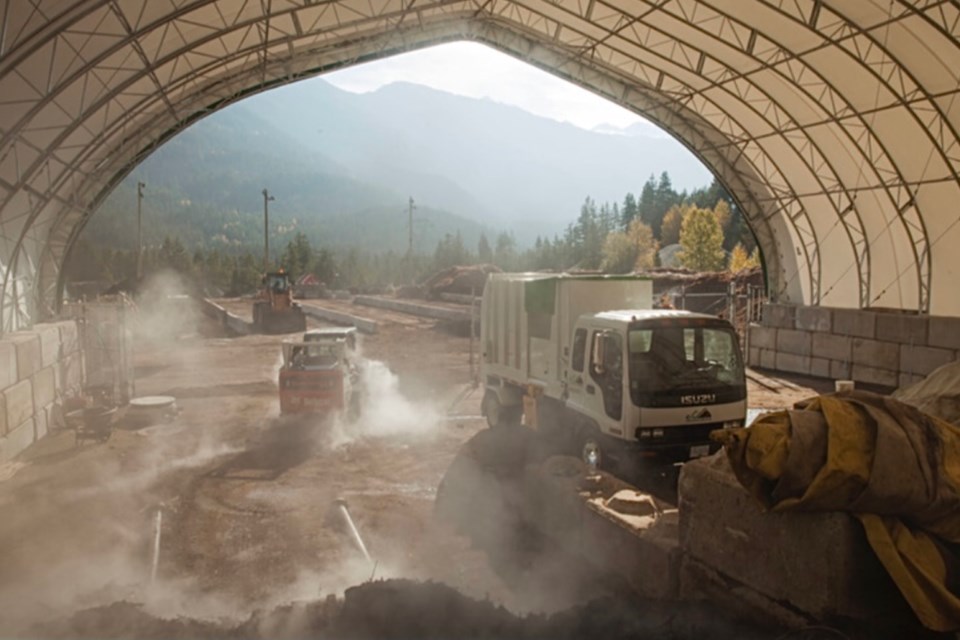City officials are hoping construction of a $30-million facility for composting both sewage sludge and household food scraps will start in the spring or summer of 2023.
The 160-metre-by-200-metre, fabric-covered structure will rise at the northeast corner of the municipal landfill site at 402 Fifth Line East.
Biosolids – mostly sludge from the city's two PUC-operated sewage treatment plants – have been an ongoing source of landfill odour issues.
This caused odour control to become a key factor in the city's selection of S-G Gore composting technology from Sustainable Generation LLC of Wilmington, Delaware.
"When you compare it to what's occurring today, where we have those biosolids being disposed of in the open air, it's going to be a significant improvement from an odour management perspective," says Rick Talvitie from AECOM, retained by the city as senior engineering consultant on the project.
Sustainable Generation was chosen over BDP Industries of Greenwich, New York.
BDP's unsuccessful proposal essentially involved composting our sludge inside a concrete tunnel.
Gore-Tex
Instead, the chosen S-G Gore technology will tuck our sewage sludge into a blanket that's an industrial version of the Gore-Tex fabric used in waterproof, windproof, breathable jackets, footwear and gloves.
The Gore fabric covers are guaranteed for five years, but often last longer.
They come with elaborate machinery for placing them over whatever's being composted.
The sludge will be laid out in windrows on a concrete slab, covered most of the time by the odour-trapping Gore fabric to minimize offensive smells.
It will be sheltered further by the fabric-walled building.
Truckloads of pudding
Right now, three trucks of PUC sludge arrive daily at the landfill, five days a week.
They're sent directly to dump the stuff at the working face of the landfill.
The local supply of sewage sludge has been fairly consistent from year to year, but if more sludge starts coming to the Sault landfill, it will be a simple matter to expand the new facility by adding additional cell structures.
Sewage sludge is about 77 per cent moisture, like truckloads of pudding when it arrives at the dump.
Wood chips
The new technology will add dry wood chips to the mixture.
"It opens up that material a little bit to allow more infiltration of that air that we are forcing into the process," Talvitie told a meeting of the city's environmental monitoring committee last week.
"This is an aerobic process," added Mike Blanchard, the city's manager of waste management and refuse.
"Right now, bringing biosolids to the landfill working face is an anaerobic process which produces methane. There is a difference and it is better for the environment."
Back to the drawing board
The project was originally supposed to be only for managing sewage biosolids.
A class environmental assessment completed several years ago made that assumption.
It recommended our biosolids be treated either with an alkaline stabilization process or through composting.
Four companies made submissions in response to a city request for statements of interest.
The city then issued a request for proposals to select a preferred technology vendor.
This time, only two companies responded: BDP and Sustainable Generation.
A light-bulb moment
Neither company was interested in providing alkaline stabilization, only in composting our sludge.
It was around this time that the provincial government started talking about managing food and organic waste.
The city, it appeared, would have to arrange for curbside collection of organics.
And then someone in the Sault asked whether that collected waste could be handled by the same facility being planned to compose our biosolids.
"It was a light-bulb moment from the perspective that we suggested maybe we want to revise the terms of reference to also include source-separated organics as a feedstock," Talvite says.
So the two vendors seeking the biosolids contract were sent back to the drawing board.
Could they incorporate source-separated organics into their planned facility for composting sewage sludge?
Separate windrows
Sustainable Generation's winning proposal involves handling the two feedstocks separately.
"It would be composted in separate windrows," Talvitie says.
"Typically, we would not be mixing it with the biosolids."
Early concepts call for separate receiving areas and separate windrows for sludge and household green waste.
After composting, source-separated organics could be used as compost on city projects.
Biosolids would be used as cover material at the landfill.
Other changes
Meanwhile, the Ontario government is planning sweeping changes to waste management and city officials are attending endless webinars in hopes of somehow divining specifics of how those changes will be implemented.
In addition to curbside collections of organics, producers of products are being made responsible for what used to be blue-box recycling, effective 2023.
"There's been an expansion of what's going to be collected: plastics, beverage containers, paper, even packaging," Talvitie says.
Other changes are expected in the handling of hazardous and special products including paints, aerosols, motor oil, etc.
As the city waits for the province to reveal how all this will work, the Sault's Household Hazardous Waste Depot closed for the season on Oct. 23.
As for the new biosolids and source-separated organics management facility at the landfill, city officials hope to have a preliminary design package ready next spring, a tender-ready package ready by the winter of 2023, with construction slated to start in the spring or summer of 2023.
